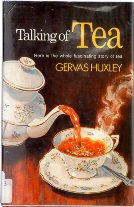ジャンピング
の 重要性
その1
その2
その3
その4
ジャンピングの言葉の元になった「Talking of Tea」に、 著者のハックスレーさんは、いったいなんと書いたのか。 以下の黒文字の文章は、1956年にイギリスのガーバス ハックスレー氏によって書かれた「Talking of Tea」という本に書かれた中から引用した文章です。(P64-P66) 「Talking of Tea」 GERVAS HUXLEY 著 1956 John Wagner & Sons Inc. 日本では、美味しい紅茶を淹れるためには、ジャンピングが重要だと言われています。
Tea is clearly a most accommodating substance. What amongst so many ways of drinking tea, is the right way? Strong brew or weak, milk or no milk, sugar or no sugar, loose tea or tea bag, hot or iced, lemon or mint, or no even butter-flavoured? Since so many different people are convinced that their way is the right way, there can be only one answer to the question. The right way to drink tea is the way you like it best. To this answer must, however, be added an important proviso. In whatever way you take your tea, the leaf should have been given the chance of bringing out its full nature and flavour. Here we leave the realm of preference enter the world of fact, because tea`s full properties and flavour will not be released unless the dry leaves have been exposed for a sufficient length of time to the action of fresh water as near the boil as possible. 紅茶は疑いもなく最も親しみやすい物質です。
It is on this fact that the simple rules for tea-making are based. Apart from being sure that the fresh water in the kettle is fiercely boiling, the injunctions to warm the teapot and to take the teapot to the kettle and not the kettle to the teapot are not just old wives' foolishness, but do, of course, help the water in the teapot to remain nearer boiling-point for a longer time than if the boiling water had been poured into a cold teapot or if the water in the kettle was well off the boil before it reached the pot.
As for the length of time needed for the full infusion of the leaves, the expert professional tea-tasters always allow five or six minutes.
But five minutes is agreed to be a sensible infusion time for the ordinary tea drinker.
In no case should less than three minutes be given. この事実、お茶を淹れるためのシンプルなルールが存在しているのです。 A very simple experiment will give a vivid practical proof of these rules. Take three glass tumblers and put a measured quantity of tea in each (1/12th oz of tea to an 8 oz glass is a suitable amount). Into the first glass pour under-boiled water (i.e. water at about 190° F.); into the second glass pour over-boiled water (i.e. water that has been boiling for about ten minutes); and into the third glass freshly boiling water. Allow in each case an infusion time of six minutes. The results will be seen to be as follows: In the first glass (the under-boiled water) about half the tea leaves rise to the top of the glass and remain there all the time, the rest remain at the bottom. In the second glass (the over-boiled water) all the leaves stay clotted at the bottom of the glass from the beginning of the infusion till the end. But in the glass in which freshly boiling water was used about two-thirds of the leaves immediately float to the top and the leaves circulate from bottom to top and top to bottom until after about three minutes all the leaves sink to the bottom. Only in this third glass have the leaves been fully exposed and their goodness drawn out. 非常にシンプルな実験が、これらのルールを証明してくれます。 There is one final rule for ensuring a good cup of tea in whatever way anyone may prefer to drink it. This is to use the best tea that you can possibly afford and to use enough of it. A pound of tea will make between 150 and 200 cups, so that even if the price of good quality tea rose to ten shillings a pound each cup would still cost less than a penny and there is a world of difference in enjoyment and refreshment between say a high quality Ceylon blend and a common tea, though the difference in price between them will be not more than a shilling or two a pound. Good quality tea is, indeed, one luxury that no one need deny himself. As regards using enough, some people like their tea weak, and others strong. No standard recipe would suit all tastes, but when tea is being made for several people, it should be remembered that a stronger brew can always be weakened by adding hot water to the cup, but nothing can be done to strengthen weak tea. The best general recipe is still, therefore, the old one of one spoonful for each person and one for the pot. 誰でも、そしてどんな飲み方が好きでも、美味しく紅茶を飲むための最終的なルールが、一つあります。それは、あなたの余裕のある限り良い茶葉を買って、そしてそれを充分な量、使うことです。 Copyright(c), 1956 Gervas Huxley
|
